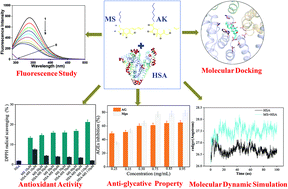The noncovalent conjugations of human serum albumin (HSA) with MS/AK and the effect on anti-oxidant capacity as well as anti-glycation activity of Monascus yellow pigments†
Abstract
Monascin (MS) and ankaflavin (AK), as typical yellow lipid-soluble pigments identified from Monascus-fermented products, have been confirmed to possess diverse biological activities such as anti-oxidation, reversing diabetes, and anti-atherosclerosis, and have received increasing attention in recent years. Certainly Monascus-fermented product with a high content of MS/AK is also a concern. The current work explored interactions between MS/AK and human serum albumin (HSA) as well as their influence on the anti-oxidant properties of MS/AK. Moreover, the anti-glycation potential of Monascus-fermented products rich in MS and AK (denoted as Mps) was assessed. The results showed that the fluorescence emission of HSA was quenched by MS/AK through a static quenching mechanism, and MS–HSA and AK–HSA complexes were mainly formed by van der Waals forces and hydrophobic interactions, but AK showed a higher binding affinity than MS. Although the DPPH radical-scavenging abilities of MS–HSA and AK–HSA complexes declined, Mps significantly reduced the formation of fructosamine, α-dicarbonyl compounds and advanced glycation end products (AGEs) in the in vitro glycation model (HSA–glucose). Notably, approximately 80% of fluorescent-AGEs were suppressed by Mps at a concentration of 0.95 mg mL−1, while aminoguanidine (AG, a reference standard) caused only 65% decrease at the same concentration. Although radical scavenging and metal chelating activities could justify the observed anti-glycation activity of Mps, in-depth research on the structures of other functional compounds present in Mps except MS/AK and reaction mechanisms should be performed. Overall, the present study proved that Mps would be promising sources of food-based anti-glycation agents because of their superior inhibitory effect on AGEs.



 Please wait while we load your content...
Please wait while we load your content...